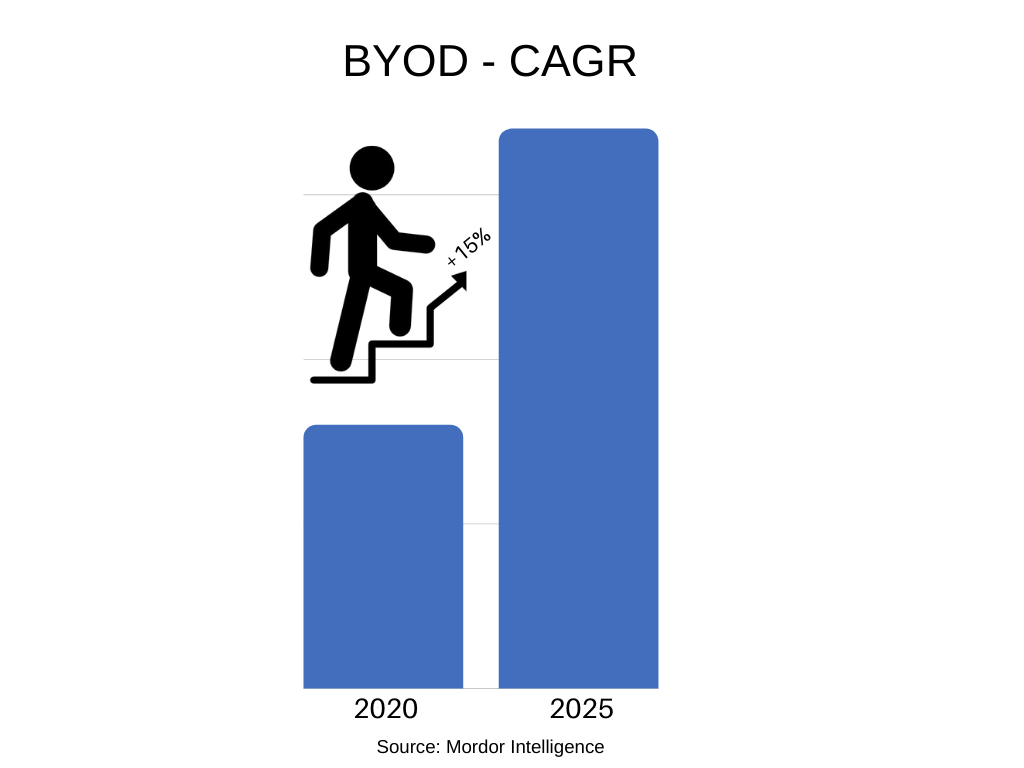BYOD, aka Bring Your Own Device, was one of the biggest revelations in the corporate world. Sure this has made a massive transformation in this firm. BYOD is not just employees using their own devices at work – it encompasses much more.
Yeah, I get your concerns, this concept can be quite a riddle.
It is kind of impossible to weigh the pros and cons to find out who wins. But I would tell you one thing for sure that to improve your productivity you should include BYOD in your company policy ASAP.
With the rise of public Wi-Fi and advanced networking facilities, communication via the internet has become an integral part of people’s daily lives. And with the growth of 4G and 5G networks around the world, BYOD is expecting a 15% Compound Annual Growth Rate in the forecast period 2020-25.

- BYOD isn’t a planned IT revolution
- Across Verticals
- The Blurring Lines between Home and Work
- The changing perception
- Employee delight through BYOD
- Contented employers and burden-free IT admins
- Empowering employee morale with BYOD
- Is BYOD an employee nightmare?
- Don’t back off, believe in GDPR
- BYOD in the shadow IT world
- MDM – Make it easy for IT admins
- What Hexnode can offer you
BYOD isn’t a planned IT revolution
Its rise to prominence has simply been through the proliferation of mobile devices brought into the workplace. When Apple released the iPad back in January 2010, it was not considered to be a work tool. It was designed and promoted to consumers for content consumption – used for watching music, playing games, and listening to music. However, it was quickly taken up by the business community with developers working on a variety of softwares from word programs and spreadsheets to apps for signing documents and more.
IPads can now be found in many business environments.
Across Verticals
It’s not just the rise of the iPads.People are choosing to use their own devices across all aspects of the business community and in all sectors. Healthcare, insurance, manufacturing – all transformed by people having access to information wherever, whenever.
The Blurring Lines between Home and Work
In today’s connected world, people don’t go to work – it’s a part of their daily life. With remote access to corporate online environments through VPNs, employees now have the flexibility to work from anywhere.
The BYOD business community doesn’t want to be in their office from dawn to dusk. They want to be able to use their own gadgets. Employers don’t have to provide a desktop anymore – the employee often has something better, faster and more efficient that they already know how to use and are always within their reach.
The changing perception
At first, BYOD seemed to be a headache for IT departments. There were security issues, problems with scalability, and issues in providing support for the plethora of devices. However, the devices which were once thought to be a pain to deal with suddenly became tools that improved productivity and boosted team morale.
Now many IT departments have less restrictive policies when it comes to BYOD, giving employees the ability to use their own devices to access the corporate IT network. This added convenience is not just good for employees – it’s good for businesses too. BYOD, in its essence, means that people can work when they are at home or when they are travelling to and from the office.
With many people choosing to work flexible hours or from out of the office, businesses need to come up with sensible and non-restrictive BYOD policies. This will help to encourage employees to come up with innovative ways to use their own devices, giving their company a more competitive edge.
Employee delight through BYOD
Consider a scenario in which you left for work early but got caught up in the traffic; it would be a complete catastrophe right. But what if you can access your work even when you are on the road. This is what you can achieve with BYOD, 24*7 information accessibility. It eliminates the burden of sitting down before a desktop at a predefined workplace at a predefined time to do your work. With BYOD and flexible work policies you can even work from home, thus walk a fine line between work and life. As an added bonus, the corporates who promote BYOD might also provide extra payment to their employees for purchasing these devices.
Contented employers and burden-free IT admins
BYOD indeed increases the risk of data loss and security heists, but most of them can be rectified by strict policies and by seeking help from third party security service providers. As the employees are already familiar and most probably up to date with their devices, the IT department won’t have to spend much time giving them necessary insights. With BYOD, employers can promote remote working and hot-desking with which companies can cut down costs. They don’t even have to put aside money for purchasing devices and are not entitled to provide any servicing.
One of the biggest scopes of BYOD is that data flow can be channeled in every direction ensuring that no one will be left out of the information loop, not even the non-desk remote workers.
Empowering employee morale with BYOD
Studies show that atleast 80% of the workforce use some kind of personal devices at work. The best that the companies can make out of it is to let them do something productive with those devices. BYOD provides flexibility to the employees to work at their most productive hours irrespective of their working time. It also removes the burden of walking around with a large number of devices by ensuring resource availability at anytime, anywhere. This saves about 81 minutes per week per worker.
Is BYOD an employee nightmare?
The answer is a bit complex. As was pointed out earlier, BYOD has certain advantages. Is keeping “the work-life balance” really one of them? Studies show otherwise. It says that the company will gain an average of 240 hours of work per person per year, this is an additional 6-week work per employee with no additional cost. Duh!
Let me give you another example. Most of the companies include a clause in their policy stating that employees will not be held accountable for data leak and malware attacks when connected to the company network. But what if this was through the apps that are installed in that employee’s personal space, this could be held as a black mark against them.
Let’s look at another one. The employees’ personal data can be accessed by the IT admin who monitors the device for security threats or other shady contents. There is a train wreck more of loopholes like this that might backfire at employees. So, deciding whether BYOD is good or bad ultimately depends on your personal experience.
Don’t back off, believe in GDPR
With the emergence of European Unions’ General Data Protection Regulation, the security issues that revolve around BYOD policies were discussed globally. GDPR enforced employee data protection through a penalty system, according to which companies might have to pay fines from 20 million dollars to 4% of the organization’s global turn over for BYOD policy violation. GDPR helped a lot to strengthen employee rights inside an organization. GDPR also made it mandatory that the organization should first get the employees written consent to access their devices’ personal space.
BYOD in the shadow IT world
Oh, the word sure does sounds spooky. So, what is shadow IT and how is it related to BYOD. This is nothing that we haven’t discussed already. Shadow IT are IT systems and solutions that your employee use which is not approved by your organization. This cannot be annihilated, the best you can do is to cherish that. Think about shadow IT as a good thing that your employees are bringing to improve overall productivity. Introducing features like cloud computing and external applications into the IT infrastructure would help in the betterment of the organization and could improve employee productivity.
MDM – Make it easy for IT admins
As BYOD was introduced to the corporate world, SMBs started making the most out of it. To prevent accompanying data leakage and security issues, firms made their employees sign their BYOD policy. But does this completely rectify all the possible threats? Apparently not. With these policies, they brought in many safety norms with which the personal device’s privacy turned to dust. But the most shocking of all is that more than 60% of the firms which use BYOD still don’t have a BYOD policy. About 80% of the employees who use BYOD haven’t signed the policy. This causes a lot of confusion in the IT department and thus a need for a more streamlined technique by which all the devices irrespective of their OS can be managed effortlessly. Dedicated mobile device management integrated with a mobile app management solution will be a quick fix for this.
What Hexnode can offer you
Hexnode is a unified endpoint management service provider, which offers the best in class management solution for all your employees’ devices. You can manage all your devices irrespective of the platform using this management tool. Some of Hexnodes BYOD features include:
- Corporate data containerization
- Corporate remote wipe
- Remote lock
- Work profile password
- App management
- App whitelisting
- App catalog
- File management
- Data management
- Location tracking
and many more.





